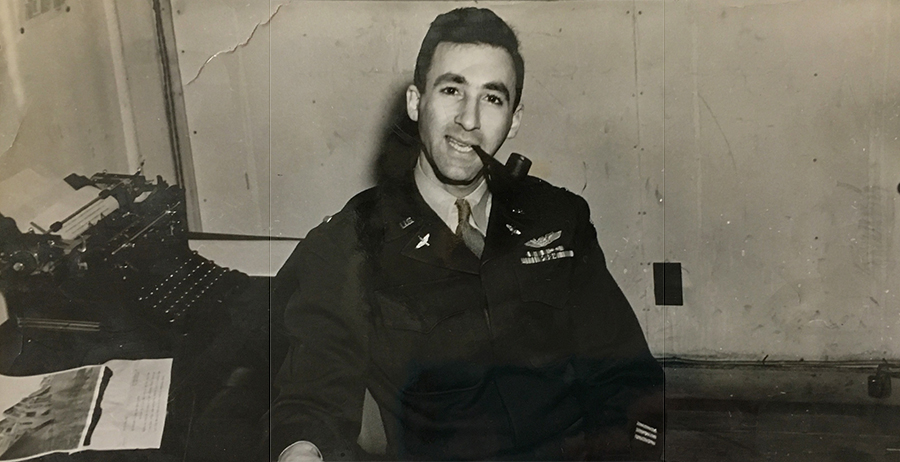Robert M. Sherman was born in 1915 and grew up in Winsted, Connecticut and The Bronx, New York. He attended the Gilbert School in Winsted, where if you got good grades you went on to an engineering college and if you didn’t you got a job in the Gilbert Clock factory. (There is an endowed chair of electrical engineering at Cooper Union in his older brother Jesse’s name.)
In 1925 his father left the family and his mother moved him, Jesse and younger sister Shirley to her parent’s house in The Bronx. After graduating from Stuyvesant High School in 1932, Robert entered Brooklyn Polytechnic Institute and a year later followed his brother to Cooper Union, but after two years towards a degree in chemical engineering he quit and took a job in radio manufacturing to help support the family. In February 1942, not cut out for academia and unhappy with his job, he jumped at the chance to enlist in the Army Air Corobert_sherman_portraitrp.
Being 27, he was older than most of his fellow enlistees. He didn’t drink and was relatively serious. One year later he became a B-26 bombardier/navigator assigned to the 556th Bomb Squadron, 387th Bomb Group and 9th AAF at MacDill Field, Tampa, FL. He arrived at Chipping Ongar, England, with crew #14, B-26 #41-31674 “Los Lobos Grande” on June 26, 1943. Francis Scurr, in the photo standing at ease next to my father beneath the nose of the bomber, remembered that my dad was quiet and kept to himself.
In February 1944 he was transferred to the B-26 1st Pathfinders Squadron (Provisional) as a navigator in one of the original crews. They trained him to use OBOE, a top secret device used in concert with ground guidance to enable highly accurate bombing under all conditions of visibility. Pathfinder ships led squadrons of other bombers to their targets in total overcast. On the ground, they and their ships were sequestered under guard to their own small area of the airfield. Otto Kirkpatrick, lead navigator of the 1st Pathfinder Squadron, told me (in his Tennessee drawl), “I don’t remember your daddy, but he must have been very good if he was with the Pathfinders.”
After completing 59 combat missions and receiving the Distinguished Flying Cross and Air Medal with 9 Oak Leaf Clusters, he arrived back in the states in early 1945. He was stationed at Bolling AFB in Washington, D.C. with the 501st Air Transport Command. After training, he worked as a public relations officer. According to his separation papers, he “Prepared or supervised preparation of news releases, special articles, photographs and other informational material; wrote articles of interest, with due regard to public relations policies and procedures. Wrote articles as ghost writer for the Commanding General, Air Transport Command.”
Air Transport Command was inactivated on June 1, 1948, and on June 17, 1948 Robert reverted to inactive status in the Reserve. His service separation papers list his permanent mailing address as being the office of J. Henry West in New York City, an attorney involved (as later mentioned in the FBI file) with the start up funding of Atomic Energy Newsletter. Eight months later, on February 14, 1949, Robert mailed out the first newsletter press releases and subscription solicitations.
Beginning small in late 1957 but expanding after he stopped the newsletter in 1961, Robert built a successful real estate business, R.M. Sherman Associates, Inc, that he continued for the rest of his life. (He also financially supported Jesse in retirement; for whatever reason, Jesse had not filed patents in his own name on his many inventions, something that never ceased to irk Robert.) Aside from bits and pieces, he rarely talked to his children about his past, and never spoke to us about the newsletter. It was my mother who mentioned he had been investigated by the FBI.
He passed away on January 9, 1995, a month and a half short of his 80th birthday. While cleaning out his closet and home office, I found a dusty cardboard carton containing service memorabilia and a small envelope of old photos. One of the photos showed him in parachute harness next to another airman standing just below the nose of the B-26 Los Lobos Grande. Both he and the other airman look young and confident. Another photo showed him smiling with a pipe in his mouth in a small office at a desk with a typewriter. In a second carton I found small boxes of microfilm and hard copies of Atomic Energy Newsletter. The newsletter apparently had been successful enough to support his family during its twelve years of publication. In fact, he told one of my cousins in amazement, “I tripled the price and they still wanted it.”

